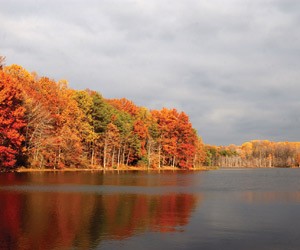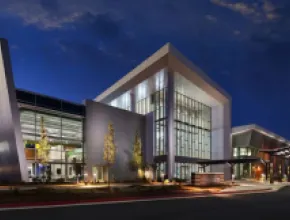The Metro D.C. region could easily brand itself as a one-size-fits-all destination. More than its role as the nation’s capital, Washington, D.C., and its neighboring Maryland and Virginia communities appeal to culture vultures, history hounds, self-appointed foodies and outdoor buffs alike with a plethora of art museums, celebrity chef hot spots, green spaces and national landmarks.
Aside from the myriad diversions, groups flock here for the area’s ease of access as well as for its ability to take care of business.
Washington, D.C.
Dubbing itself a “Powerful Place,” Washington, D.C., certainly packs a punch with its slew of history and visual arts museums, interactive exhibits and presidential and war memorials. Attendees can hop on Segways or bikes for tours of the National Mall or make use of the extensive Metro system to access the city’s mix of neighborhoods as well as its Walter E. Washington Convention Center.
The convention center will be adding a Marriott Marquis hotel, due to open in 2014.
“We broke ground on the Marriott Marquis hotel connected to the convention center,” says Elliott Ferguson, president and CEO of Destination DC. “We’re excited about that being under way.”
The hotel will offer 1,175 guest rooms and 100,000 square feet of meeting space and will be connected by walkway to the convention center. Meeting space will include a 30,000-square-foot grand ballroom and two 10,800-square-foot junior ballrooms.
With the Marriott’s ballrooms, the center will be able to host simultaneous events.
“The key thing for us is we have always wanted to maximize the convention center,” Ferguson says. “This will create the perfect scenario where we can host one meeting in one section of the building and another show in another part of building. It keeps the hotels and building busy.”
The new Marriott Marquis will join existing meetings standouts such as the Washington Hilton, the Renaissance Washington, D.C. Downtown and the Grant Hyatt Washington.
D.C. is also undergoing other developments, including the new CityCenterDC mixed-use project on the site of the city’s old convention center. The plan is for 60 retail stores, a 300- to 400-room hotel and condos, with the first phase to be completed in 2014. According to Ferguson, the O Street Market project, or City Market at O, is another venture in the works and will include 189 hotel rooms, 10,000 square feet of retail space, a restaurant, condos and apartments.
Another area under development is Southeast Washington, home of the Washington Nationals baseball park.
“That area of town is not far from downtown and for a long time was not very pleasant,” Ferguson says. “But since the ballpark was completed, there has been new building and development.”
The park is located along the fast-developing Capitol Riverfront district and near the growing Southwest Waterfront, home to a newly revamped Arena Stage, which hosts performing arts groups and is available for receptions.
“Arena Stage reopening is a phenomenal addition to Southwest Waterfront,” Ferguson says. “Outside New York, D.C. has more theater seats than any other city in the country.”
Along with the performing arts scene, the city’s dining diversity is also a draw. A number of celebrity chefs are represented, including Jose Andres, Carla Hall and Spike Mendelsohn, as well as Oprah’s former chef Art Smith, who owns Art and Soul.
“As the restaurant scene continues to improve significantly, we are looking at ways to encourage more business in the city with attractions D.C. is not known for,” Ferguson says.
To help planners parse through all the dining, theater and arts options for off-site venues, Destination DC recently released a guide to unique spaces, including the House of Sweden Embassy, American Pharmacists Association Headquarters and Hay Adams Hotel rooftop.
Other off-site options include any of the Smithsonian museums. Smithsonian’s National Museum of African American History and Culture will open in 2015.
Maryland
Within the D.C. corridor, Prince George’s County emphasizes its location near the nation’s capital as well as its own unique flavor.
“Obviously, proximity isn’t our only asset,” says Carl Smith, marketing manager for the Prince George’s County, Maryland CVB. “A fast-growing segment of our meetings menu is the use of non-traditional venues.”
Newton White Mansion, located on the grounds of the Enterprise Golf Course in Mitchellville, offers a tranquil setting for groups. The grounds of another picturesque spot, Oxon Hill Manor, include formal English gardens and an expansive patio for outdoor events.
Oxon Hill Manor is located close to the entrance of National Harbor, one of the area’s newest additions, set on 300 acres along the Potomac River. Venues at National Harbor include the Pier Platforms on the Potomac as well as the indoor Sunset Room. Groups can also make use of the Gaylord National Resort & Convention Center at National Harbor.
Next door, Montgomery County serves as a hub for business and biotechnology and is also the headquarters of Ritz-Carlton and Marriott International, among other chains.
The county’s location just eight miles from downtown D.C. is a big selling point, as is its 13 Metro stations along the Red Line, putting many hotels within walking distance.
Aside from proximity, Montgomery provides 10,000 hotel rooms, many located in the towns of Bethesda and Silver Spring. In addition, the Silver Spring Civic Building opened last year and is available to groups.
“We definitely have a lot of our own appeal, a lot of urban districts and town centers, over 900 restaurants, lots of shopping. We also have wineries in the county and a lot of outdoor activities,” says Natalie Ramos, director of sales for the Conference and Visitors Bureau of Montgomery County, MD.
Groups can participate in a winery tour and tasting at Sugarloaf Mountain Vineyard, where there are also hiking and biking trails.
For off-site options, Silver Spring is debuting a new performing arts venue, The Fillmore, in September. Adventure Park at Sandy Spring features a new ropes and zip-line course and can be used for team building.
Virginia
Just across the Potomac River from D.C., Arlington lays claim to a number of key regional attractions, including the Arlington National Cemetery. This year, the city was also named a Distinctive Destination by the National Trust for Historic Preservation.
“So many people who hold meetings here are repeat visitors, but when we get planners who haven’t experienced Arlington yet, we absolutely hear positive reviews,” says Emily Cassell, director of the Arlington Convention and Visitors Service. “They think of us as a suburb of D.C. but are pleasantly surprised by how lively our neighborhoods are and how much there is to see and do.”
Arlington’s neighborhoods, or “urban villages,” include Crystal City, with the largest number of meetings hotels, and Roslyn.
One of the most recent additions is Artisphere, an urban arts center, with numerous meeting and event facilities, including the 4,000-square-foot Terrace Gallery and 220-seat Dome Theatre.
For outdoor pursuits, Arlington offers 86 miles of bicycle trails, including the 17-mile Mt. Vernon Trail. The city now features the Capital Bikeshare system, with 14 rental locations primarily around Washington Metro stations throughout the county.
Just south of Arlington, Alexandria spotlights its distinctive flavor. The historic center, or Old Town, brims with boutiques, restaurants, antique shops and theaters, as well as 18th and early 19th century architecture. It is also easily accessible to D.C. as well as the three area airports.
“We’re also a very walkable city,” says Lorraine Lloyd, vice president of sales for the Alexandria CVB. “There is a free King Street Trolley as well as biking activities, such as bike history tours and biking to Mt. Vernon. We’re very eco-friendly.”
The city is also sporting a new conference center—the high-tech Mary M. Gates Learning Center at United Way Worldwide.
“It’s a really nice contrast to the historic ambience of Alexandria,” Lloyd says.
Lloyd also notes that the CVB has been upgrading its website with more downloadable PDFs on dining, hotels and attractions.
“We’re also very lucky the city approved us to bring on a third sales person, which will allow us to focus on specific market segments—government, association and corporate.”
Some unique options for groups include the Torpedo Factory Art Center, George Washington Masonic Memorial and Gadsby’s Tavern Museum.
Fairfax County is home to the headquarters of the CIA, as well as over 300 associations and half the metropolitan area’s Fortune 500 companies. Many of the headquarters locations are in Reston, Tysons Corner and the Dulles Corridor near Washington Dulles International Airport.
“The big news is that the Washington Metro Rail System is adding stops to Tysons Corner and Reston, and will have trains running by December 2013,” says Dean Miller, national sales manager for Visit Fairfax. “There will be four stops in Tysons Corner and one in Reston and the next phase is all the way to Dulles Airport.”
The new trains are part of a multibillion-dollar transportation improvement program, the Dulles Corridor Metrorail Project. Service is expected to reach the airport by 2016.
“There are other stops in the county now but getting to Tysons Corner is a big thing,” Miller says. “It’s the county’s downtown, with 12 hotels and two major shopping malls. It will definitely allow us to attract groups that haven’t considered us before.”
Miller says there are discussions regarding construction of a new conference center near one of the new Metro stops at Tysons Corner, but an opening date has not been set.
The county offers 20 meetings hotels, including the Hilton McClean Tysons Corner, which is undergoing a $45 million renovation.
Fairfax County is also home to the Space Shuttle Enterprise at the Smithsonian National Air and Space Museum’s Steven F. Udvar-Hazy Center, which will soon add Space Shuttle Discovery to its collection.







